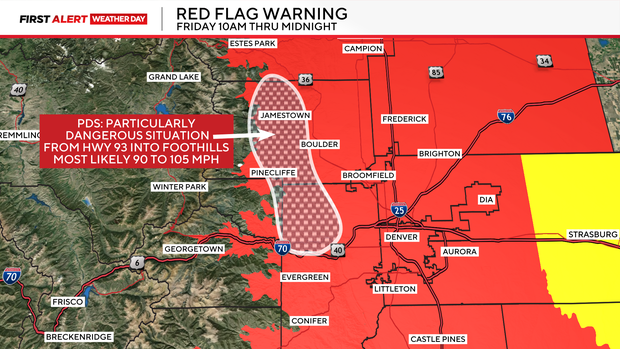Colorado
Efforts to build an “airport city” called Colorado Aerotropolis are now official

After years of discussions and planning, a metro-area partnership has declared efforts to build out an aerotropolis — an airport city — around Denver International Airport officially off the ground.
The group of elected officials and staffers from cities, Adams County, Denver and the airport are elevating their plans to turn undeveloped areas around DIA into a hub for commerce, a magnet for innovative enterprises and an even more powerful economic engine for metro Denver and Colorado.
A website for Colorado Aerotropolis pitches the region to “makers and manufacturers, builders and developers.” At the heart of the appeal is DIA, the third-busiest airport in the U.S. and the sixth-busiest in the world.
And another big selling point is that the Denver airport, which opened in February 1995 on land annexed from Adams County, is its location: surrounded by thousands of acres of undeveloped land, not in the middle or on the edges of a dense cityscape.
“Frequently airports are built in areas that are already quite populated and that’s going to be somewhat limiting,” said Jenni Hall, director of Adams County’s Community and Economic Development.
“Denver International Airport is the second largest in terms of land mass in the world,” said Ken Cope, senior vice president of real estate development at DIA. “We have that luxury of having a very large canvas to paint on.”
The Aerotropolis Regional Committee is made up of representatives from Adams County; the cities of Aurora, Brighton, Commerce City, Federal Heights and Thornton; the City and County of Denver; and DIA. Members first signed a marketing agreement about eight years ago, said Adams County Commissioner Emma Pinter.
“The official launch is a formal way of announcing to the globe that the aerotropolis around DIA is open for business. There are parcels in every one of our jurisdictions that are for sale and ready for development,” Pinter said.
An aerotropolis is designed to place cities around a central airport, leveraging the connectivity that air travel provides. Hall said there are about 16 such developments around the world. A public-private partnership is behind an aerotropolis in Atlanta, home to the Hartsfield-Jackson Atlanta International Airport, the world’s busiest.
“The notion of an aerotropolis is one that is much more acceptable in foreign markets,” Cope said.
The model of building around an airport is something the U.S. is just starting to embrace, Cope added.
The concept encountered turbulence early on in Colorado. Adams County said Denver’s initial visions for developing the area violated the 1988 agreement on Denver’s annexation of the land.
The intergovernmental agreement that cleared the way for construction of DIA, which replaced Stapleton International Airport in Denver, was amended in 2016.
“In that amendment there was a committee that was formed to promote regionalism and development in the area,” Cope said. “But land development takes time.”
Pinter, Hall and Cope all said the regional committee has focused on collaboration among the different entities.
“I now think we’re at a point where jointly between Adams County, the airport and surrounding municipalities, we’re ready to accelerate development,” Cope said. “We’re working jointly to make sure that development is cohesive, that you’ve got the right infrastructure in place.”
The regional committee’s current budget is $1.03 million, with half coming from the airport and half from the other members of the regional committee.
The kinds of businesses the committee believes are naturals for the area include ones in such sectors as agriculture, biomedical, quantum computing, energy, advanced manufacturing and transportation. The committee’s talking points include the area’s renowned colleges and research facilities, educated workforce and the 28 international nonstop destinations served by DIA.
A study released in 2023 said that DIA’s total economic contribution to Colorado’s economy was about $36.4 billion. The airport can help drive further business opportunities and compatible development near the airport and also in the region, Phil Washington, the airport’s CEO, said in a statement.
Pinter noted that the area generally encompassing the aerotropolis contains all the state’s intersecting highways, including Interstates 70, 25 and 76.
“We also have rail lines that serve all sides of the aerotropolis,” Pinter said. “Whether you’re moving goods by rail, highway or air, this is a central location for businesses to locate.”
Aurora Mayor Mike Coffman said in a statement that Colorado Aerotropolis will provide companies direct access to such “current powerhouses” as like the Gaylord Rockies resort and convention center, the Fitzsimons Innovation Community and the Anschutz Medical Campus.
The Aurora Highlands housing development, which held its grand opening in 2023, is in the planning area.
Hall said the region also is part of a designated foreign trade zone, which provides specific tax and customs advantages for the global movement of goods.
When Cope thinks about the aerotropolis, he envisions an entire city taking shape. He said there’s an opportunity to build something similar to the existing metro area.
Denver annexed 53 square miles, or 34,000 acres for DIA. The airport has six runways and has been approved for 12.
“Even after we build all 12 of those runways, there are about 16,000 acres left that the airport will own for commercial development,” Cope said.
Get more real estate and business news by signing up for our weekly newsletter, On the Block.

Colorado
Avs’ home heater continues as Colorado beats Winnipeg 3-2 in chippy win

The Avs on home ice remain as close to invincible as a sports team can get.
Colorado beat Winnipeg 3-2 on Friday at Ball Arena, improving to 14-0-2 in Denver. The win extended the longest home point streak to start a season in franchise history, and the Avs’ 12th straight victory at home is the longest in the NHL this season and second-longest streak in franchise history.
“When other teams play here, it’s tough to come into this building,” defenseman Josh Manson said. “When the fans get behind us, momentum shifts. We score a goal, they get loud, the building gets rocking and the momentum starts to carry and we can feel it. And from there, we can start pouring it on.”
The Avs didn’t play perfect on Friday, giving up a shorthanded goal and battling through several Winnipeg surges after reigning Hart Trophy and Vezina Trophy winner Connor Hellebuyck settled into the game.
But as they have all season, Colorado found a way to win in front of the Avs faithful in a game featuring four scuffles, highlighted by a fist fight between Manson and the Jets’ Tanner Pearson. The Avs’ only home losses this year came in a pair of 5-4 shootout setbacks, to Dallas on Oct. 11 and Carolina on Oct. 23.
Since then, Colorado’s been a sure bet to prevail at “The Can.”
“This was one of our better defensive efforts of the year — physical, and we spent some time in the D-zone in the second period and didn’t give up any dangerous chances five-on-five really,” Avs head coach Jared Bednar said. “Made a mistake on the power play, made a mistake on the penalty kill, but besides that I liked our game tonight.”
The Avs started fast against struggling Winnipeg, which has battled injuries and inconsistencies while looking like a shadow of the team that won last season’s Presidents’ Trophy. Colorado blitzed Hellebuyck with a number of quality shots in the first 10 minutes, then finally broke through with Brent Burns’ goal.
“Right from the drop of the puck, we were taking it to them,” Manson said. “… (During this stretch of home dominance) we’ve set the pace on teams.”
Burns, the oldest active NHL player, wristed one home from behind the right playoff circle as his shot deflected off the skate of a Winnipeg defender to make it 1-0.
Five minutes later, Colorado made it 2-0 thanks to a highlight-reel combination between Nathan MacKinnon and Martin Necas. MacKinnon, tied with Edmonton’s Connor McDavid for the NHL points lead entering the night with 58, made a precise pass that split two defenders and found Necas streaking down the center of the ice. Necas beat Hellebuyck on the bottom right shelf.
“When we beat them up ice, we’re capable (of finishes like that),” Necas said.
But in the second period, Hellebuyck tightened up, turning away several scoring chances as the Jets killed three Avs power plays and the crowd buzzed off of Manson’s fight with Pearson.
After both players went to the penalty box just under three minutes into the period, the jumbotron cam jumped from Manson to Pearson, with the former getting met with deafening cheers and the latter with a chorus of boos.
“(That) gets you fired up a little bit,” Parker Kelly said.
But on Colorado’s third man-advantage of the period, the Jets stole the momentum back with a short-handed goal.
Off a Hellebuyck save, Alex Iafallo possessed the puck and cleared up ice high off the glass. Morgan Barron outskated Cale Makar down the ice to retrieve the bouncer, then beat Scott Wedgewood one-on-one with a backhanded shot to quiet the crowd and make it 2-1 with 37 seconds left in the frame.
“We weren’t worried after that,” Manson said. “If anything, I was thinking in my mind, ‘We’re going to go get one here at the start of the third period.’”
The Avs did just that.
Less than two minutes into the third, Colorado grabbed the mojo right back. Manson blasted a shot from up near the blue line, which deflected off a screening Kelly and past Hellebuyck for a 3-1 lead.
“I saw it go to low to high and I just tried to beat my guy to the net,” Kelly said. “(Manson) was walking down mainstream. Honestly, I was just there to try and provide a screen. I thought (Manson) was going to rip it. I don’t know if it got tipped, but the shot was along the ice and my stick was on the ice. Just tried to get a little touch on it.”
But the Jets quickly answered about 90 seconds later, capitalizing on a hooking penalty on Devon Toews as Mark Scheifele scored just seven seconds into Winnipeg’s power play to again make it a one-goal game.
Midway through the period, the Avs had a goal wiped off the board. Kelly deflected the puck into the net off a shot by Samuel Girard, but Kelly used high-sticking to do it, negating the score.
From there, Wedgewood and the Colorado defense held on as the Avs notched their 56th and 57th points of the season. Wedgewood made 20 total saves, including two saves in the final minute to seal the win for Colorado (25-2-7).
“We got heavy around the net, and Wedgie played great between the pipes,” Manson said. “We were making good decisions with the puck at the end of the game… We made smart plays and didn’t force anything in the last eight, 10 minutes of that game.”
The longest home win streak in Avs history came during their championship season in 2021-22, when Colorado won 18 straight in Denver from Nov. 11 to Jan. 30.
Want more Avalanche news? Sign up for the Avalanche Insider to get all our NHL analysis.
Colorado
Several Colorado highways temporarily closed due to high winds

BOULDER, Colo. (KKTV) – Several Colorado highways are closed due to high winds reaching up to 80 MPH in some locations.
According to the Colorado Department of Transportation (CDOT), the closures currently in place include:
- CO 93 both directions from 64th Ave (Arvada) to CO 170.
- CO 72, both directions from CO 7 to Ward Road.
- US 36, both directions from Boulder to Lyons.
- CO 128, both directions from CO 93 to McCaslin Boulevard.
Transportation officials said the winds may also cause traffic signal outages.
If traffic lights are experiencing a power outage, CDOT said drivers must treat it as a four-way stop:
- Come to a complete stop at the stop line or before entering the intersection.
- Vehicles proceed one at a time, in the order they arrived.
- If two vehicles arrive at the same time, the driver on the right goes first.
- Always yield to pedestrians and cyclists already in the crosswalk.
- Make eye contact when possible and proceed cautiously – do not assume others will stop.
Drivers are also encouraged to reduce speeds, keep both hands firmly on the steering wheel, and be alert for debris, downed signs and sudden gusts. High-profile vehicles, such as trucks, vans and vehicles towing trailers, are encouraged to avoid travel when closures or restrictions are in place.
CDOT also reminds commercial drivers to ensure tire chains are properly secured and not dragging, which can create sparks and increase wildfire risk during dry, windy conditions.
Copyright 2025 KKTV. All rights reserved.
Colorado
Dangerous fire situation looming for parts of Colorado’s Front Range, as another day of strong winds lies ahead

Dangerous weather conditions in Colorado are expected to team up for a surge in the Front Range fire danger. For most of the day Friday conditions will be favorable for rapid fire spread. Avoid outdoor burning and any activity that may produce a spark. Friday will be a First Alert Weather Day.
The triple threat of hurricane force winds, record heat and single digit relative humidity will all be in force from 10 a.m. to midnight on Friday. That is when a red flag warning for high fire danger is issued.
For the first time in Colorado, the National Weather Service office in Boulder has issued an extra warning know as “A Particularly Dangerous Situation” for northwest Jefferson and western Boulder counties for possible wind gusts of 85 to 105 mph.
The worst areas will be from Highway 93 up into the higher foothills. That, combined with single digit relative humidity, will make conditions worse that what the state experienced on Wednesday.
For the northern Front Range, the strongest winds will be west of I-25 into the foothills. Along and east of the I-25 corridor including the Denver metro area, winds may gust up to 40 mph with humidity levels as low as 8%. For that reason, the entire Denver metro area is in the warning area.
The strong winds will be warming downslope winds for eastern Colorado with highs on Friday shooting up into the 60s and 70s. Denver may have a new record high of 70 degrees. The old record is 67 degrees last set in 2023.
Top wind gusts may likely be stronger than Wednesday. Those gusts were hurricane force in some areas of the foothills and mountains with gusty winds comparable to those of a category 2 or 3 hurricane.
-

 Iowa5 days ago
Iowa5 days agoAddy Brown motivated to step up in Audi Crooks’ absence vs. UNI
-

 Iowa7 days ago
Iowa7 days agoHow much snow did Iowa get? See Iowa’s latest snowfall totals
-

 Maine4 days ago
Maine4 days agoElementary-aged student killed in school bus crash in southern Maine
-

 Maryland5 days ago
Maryland5 days agoFrigid temperatures to start the week in Maryland
-

 Technology1 week ago
Technology1 week agoThe Game Awards are losing their luster
-

 South Dakota6 days ago
South Dakota6 days agoNature: Snow in South Dakota
-

 New Mexico3 days ago
New Mexico3 days agoFamily clarifies why they believe missing New Mexico man is dead
-

 Nebraska1 week ago
Nebraska1 week agoNebraska lands commitment from DL Jayden Travers adding to early Top 5 recruiting class

























